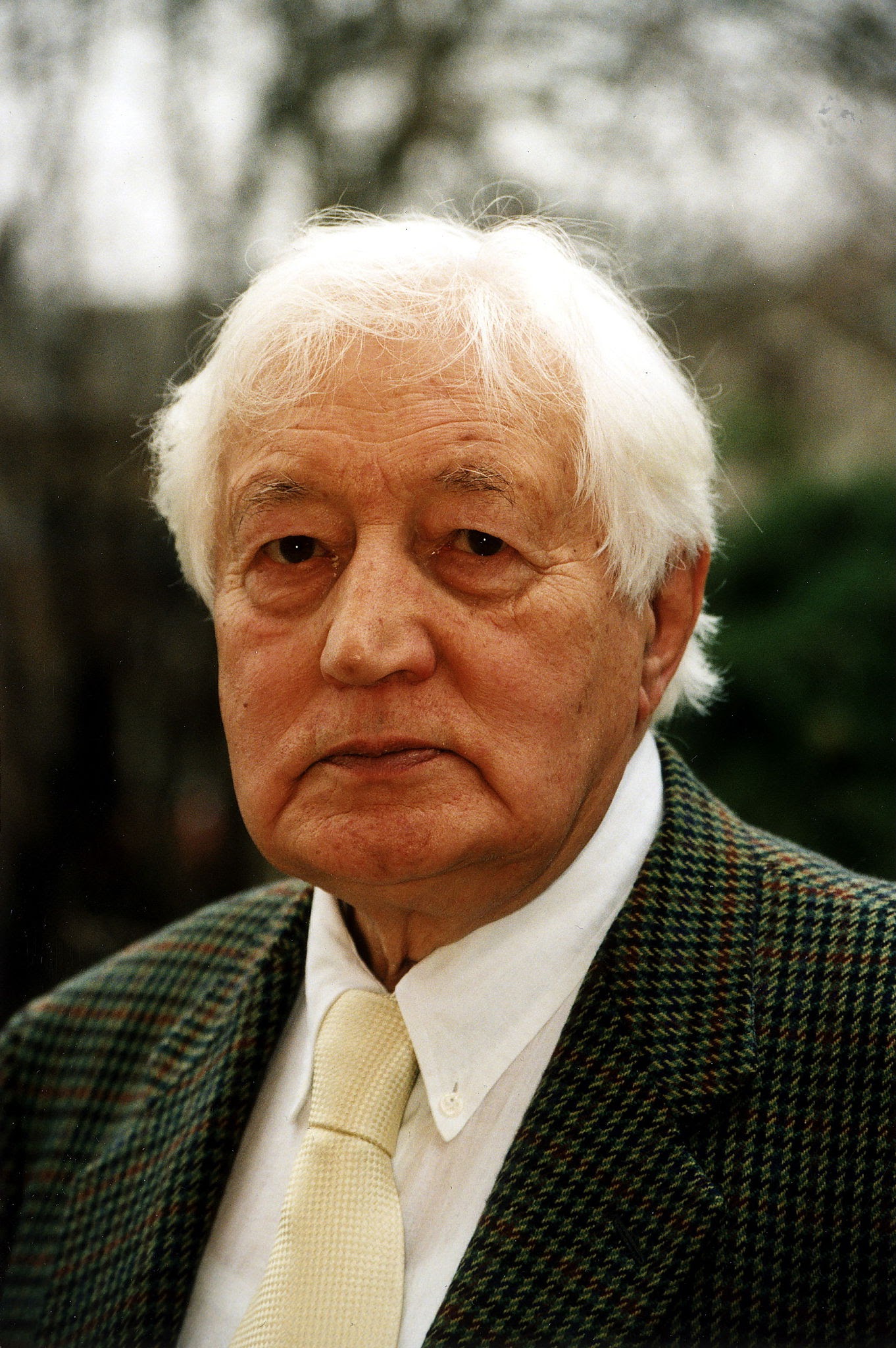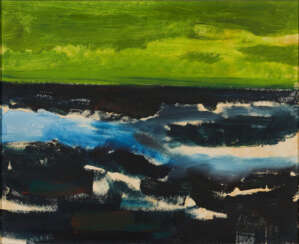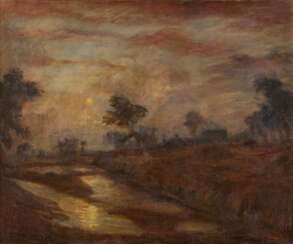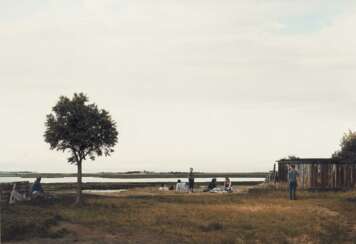пейзаж природа

Heinrich Kamps or Heinz Kamps was a German painter and director of the Düsseldorf Academy of Fine Arts.
In 1922, Kamps first presented his work to the public by participating in an exhibition of the artists' association "Das Junge Rheinland". Soon, in 1925, he was already appointed professor at the Düsseldorf Academy of Fine Arts, and four years later he took over the management of the State Art School in Berlin-Schöneberg.
During the Nazi "Degenerate Art" campaign in 1937, Kamps' works were confiscated and lost. In 1941 he was forced to leave for Austria and then Poland; in 1943 his Berlin studio was bombed by the Allies and almost all of his early works destroyed.
After the end of World War II, in 1946 Kamps was elected professor and director of the newly opened Düsseldorf Academy of Art, which he directed until his death.


Anton Henning is a German self-taught artist, designer, sculptor and installer.
He lives and works in Berlin, London and New York and has established himself as a talented and extraordinary furniture and interior designer. Henning is inspired by views of world capitals while developing his own avant-garde styles. He also wittily analyzes art history through his installations, sculptures and paintings.


Per Kirkeby was a Danish painter, poet, film maker and sculptor.


Siegward Sprotte was a German artist, writer and philosopher.
Originally Siegward Sprotte painted figuratively, including portraits of old masters and drawings. Later he devoted himself more to landscape, up to the ideogram and colourful calligraphy.
Sprotte has written many works on the subjects of art, consciousness and modernity, and is the creator of a new paradigm of "eye-to-eye".


Siegward Sprotte was a German artist, writer and philosopher.
Originally Siegward Sprotte painted figuratively, including portraits of old masters and drawings. Later he devoted himself more to landscape, up to the ideogram and colourful calligraphy.
Sprotte has written many works on the subjects of art, consciousness and modernity, and is the creator of a new paradigm of "eye-to-eye".


Siegward Sprotte was a German artist, writer and philosopher.
Originally Siegward Sprotte painted figuratively, including portraits of old masters and drawings. Later he devoted himself more to landscape, up to the ideogram and colourful calligraphy.
Sprotte has written many works on the subjects of art, consciousness and modernity, and is the creator of a new paradigm of "eye-to-eye".


Siegward Sprotte was a German artist, writer and philosopher.
Originally Siegward Sprotte painted figuratively, including portraits of old masters and drawings. Later he devoted himself more to landscape, up to the ideogram and colourful calligraphy.
Sprotte has written many works on the subjects of art, consciousness and modernity, and is the creator of a new paradigm of "eye-to-eye".


Manfred Henninger was a German painter, draughtsman, graphic artist, ceramist and university lecturer. As an artist, he belongs to the lost generation.
His works often revolve around the themes of the human figure and landscape and can be described as late impressionist.
Manfred Henninger was a member of the Deutscher Künstlerbund.


Fritz Klemm was a German painter. He taught as a professor at the State Academy of Fine Arts in Karlsruhe.


Heinrich Vogeler was a German artist and philosopher, a representative of the German Art Nouveau. A versatile and talented artist, he painted, watercolored, composed poems, designed, designed and decorated. Over time, his style of art changed over a wide range.
During World War I, from 1914 to 1917, Vogeler was on the Eastern Front as a volunteer and made sketches, which resulted in his pacifist sentiments.
In the mid-1920s he visited the Soviet Union several times and his impressions resulted in paintings in his own "complex style: "Karelia and Murmansk" (1926), "Building a New Life in the Soviet Republics of Central Asia" (1927), and "Baku" (1927). In 1931 Vogeler received an invitation to work in the USSR. The coming to power of the Nazis in Germany made it impossible for him to return home, and after Hitler's invasion Vogeler among many was deported to the Kazakh SSR, where he died.


Anett Stuth is a German photographer. With her photographs, Anett Stuth invents multiple architectures in which interior and exterior, high and popular culture, photography and painting overlap. From basic documentary motifs, Stuth layers and collages imaginary interiors, urban or natural landscapes. At the same time, they make the possibility space of the virtual age perceptible. With the technique she has been developing since 2003, Stuth transcends the usual dimension of photographic space and redefines it.


Horst Janssen was a German graphic artist, printmaker, poster and illustrator. He created many drawings, etchings, woodcuts, lithographs, and woodcuts.
There is a museum dedicated to his legacy in Horst Janssen's hometown of Oldenburg. His works are represented internationally in major museums.


Siegward Sprotte was a German artist, writer and philosopher.
Originally Siegward Sprotte painted figuratively, including portraits of old masters and drawings. Later he devoted himself more to landscape, up to the ideogram and colourful calligraphy.
Sprotte has written many works on the subjects of art, consciousness and modernity, and is the creator of a new paradigm of "eye-to-eye".


Axel Kassebömer was a German artist known for his innovative and multidisciplinary approach to art.
Axel Kassebömer's artistic practice was characterised by a combination of conceptual and visual elements. He often explored the intersection of art, science and technology, incorporating scientific principles and mathematical concepts into his work. His art sought to provoke thoughtful contemplation and challenge traditional notions of perception and reality.
In his paintings, Kassebömer used geometric shapes, intricate patterns and vivid colours. He played with spatial relationships and optical illusions, creating dynamic compositions that invited viewers to engage intellectually and sensorially with works of art.
Axel Kassebömer's interest in photography led him to experiment with capturing movement, time and light. He used long exposures and multiple exposures to create abstract and ethereal images that conveyed a sense of fluidity and transformation.


Otto Eglau was a German graphic artist.
During World War II he served in the Nazi army and was a prisoner of war. After his liberation, Eglau studied at the Berlin Academy of Art and taught free drawing and painting at the Technical University of Berlin. Between 1951 and 1970, Eglau made study trips around the world and taught etching technique at the International Summer Academy of Fine Arts in Salzburg. From 1983 until his death in 1988, he worked alternately in studios in Berlin and on the island of Sylt.


Jörg Immendorff was a German painter and sculptor, stage designer and decorator, and a member of the New Wild movement.
Immendorff painted in cycles that often lasted for years and were political in nature. His series of sixteen large paintings, Café Deutschland (1977-1984), is well known. In these colorful paintings, numerous disco lovers symbolize the conflict between East and West Germany.
Immendorff prepared several stage productions and designed sets for the operas Elektra and The Rider's Voyage. 25 of Immendorf's paintings were selected in 2006 for the illustrated Bible.


Franz Heckendorf was a German painter and graphic artist who was particularly successful during the Weimar Republic. During the National Socialist era, he was sentenced to ten years in prison after helping Berlin Jews threatened with deportation to extermination camps to escape to Switzerland.


Friedrich Wilhelm Otto Modersohn was a German painter of the late 19th and first half of the 20th centuries. He is known as a landscape painter, a representative of the Barbizon School.
Otto Modersohn produced Barbizonian-style landscapes early in his career, but from about 1890 his style became more expressionist, with an emphasis on his choice of colors. The death of his second wife influenced his style: the colors became darker and the images more stark. Modersohn was one of the founders of the Worpswede artists' colony. A large collection of his works is kept in the Modersohn Museum in Fischerhude, and a street in Berlin is also named after him.


Friedrich Wilhelm Otto Modersohn was a German painter of the late 19th and first half of the 20th centuries. He is known as a landscape painter, a representative of the Barbizon School.
Otto Modersohn produced Barbizonian-style landscapes early in his career, but from about 1890 his style became more expressionist, with an emphasis on his choice of colors. The death of his second wife influenced his style: the colors became darker and the images more stark. Modersohn was one of the founders of the Worpswede artists' colony. A large collection of his works is kept in the Modersohn Museum in Fischerhude, and a street in Berlin is also named after him.


Friedrich Wilhelm Otto Modersohn was a German painter of the late 19th and first half of the 20th centuries. He is known as a landscape painter, a representative of the Barbizon School.
Otto Modersohn produced Barbizonian-style landscapes early in his career, but from about 1890 his style became more expressionist, with an emphasis on his choice of colors. The death of his second wife influenced his style: the colors became darker and the images more stark. Modersohn was one of the founders of the Worpswede artists' colony. A large collection of his works is kept in the Modersohn Museum in Fischerhude, and a street in Berlin is also named after him.


Friedrich Wilhelm Otto Modersohn was a German painter of the late 19th and first half of the 20th centuries. He is known as a landscape painter, a representative of the Barbizon School.
Otto Modersohn produced Barbizonian-style landscapes early in his career, but from about 1890 his style became more expressionist, with an emphasis on his choice of colors. The death of his second wife influenced his style: the colors became darker and the images more stark. Modersohn was one of the founders of the Worpswede artists' colony. A large collection of his works is kept in the Modersohn Museum in Fischerhude, and a street in Berlin is also named after him.































































